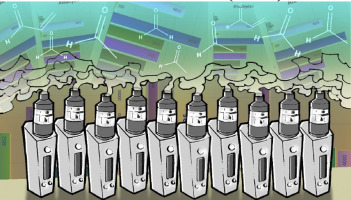当前位置:
X-MOL 学术
›
Regul. Toxicol. Pharmacol.
›
论文详情
Our official English website, www.x-mol.net, welcomes your
feedback! (Note: you will need to create a separate account there.)
Determining the impact of flavored e-liquids on aldehyde production during Vaping.
Regulatory Toxicology and Pharmacology ( IF 3.0 ) Pub Date : 2020-01-27 , DOI: 10.1016/j.yrtph.2020.104588 I Gene Gillman 1 , Alexander S C Pennington 1 , Kathy E Humphries 1 , Michael J Oldham 2
Regulatory Toxicology and Pharmacology ( IF 3.0 ) Pub Date : 2020-01-27 , DOI: 10.1016/j.yrtph.2020.104588 I Gene Gillman 1 , Alexander S C Pennington 1 , Kathy E Humphries 1 , Michael J Oldham 2
Affiliation

|
1,2-Propylene glycol and glycerin, principal components of e-liquids, can thermally degrade to form acetaldehyde, acrolein, and formaldehyde when heated in electronic nicotine delivery systems (ENDS). Recently the flavors in e-liquids were suggested to be the major source of these aldehydes. We used the same 10 ENDS devices to test 5 e-liquid formulations (four flavored & one corresponding non-flavored) and measured device mass loss and levels of acetaldehyde, acrolein, and formaldehyde (30 replicate measurements per formulation). Despite finding reasonable variability in measurements of device mass loss, two out of 10 ENDS devices tested produced outlier values for aerosol levels acetaldehyde, acrolein, and formaldehyde. After removing these devices from further analysis, acceptable variability (≤20% RSD) in aerosol levels of acetaldehyde, and formaldehyde were found. The flavored formulations tested resulted in a consistent and selective increase of 150%-200% in acetaldehyde, no increase or decrease in acrolein and depending on the flavor formulation, an increase, a decrease or no change in formaldehyde levels. Comparison of our results to the literature illustrates the need for development of a standardized ENDS testing protocol. Our results further support that device variability must be fully characterized and considered before assessing the impact of e-liquid formulations.
中文翻译:

确定加香的电子液体对Vaping过程中醛产生的影响。
电子液体的主要成分1,2-丙二醇和甘油在电子尼古丁传送系统(ENDS)中加热时,会热降解形成乙醛,丙烯醛和甲醛。最近,电子液体中的香料被认为是这些醛类的主要来源。我们使用相同的10台ENDS设备测试了5种电子液体制剂(四种调味剂和一种相应的非调味剂),并测量了器械的质量损失以及乙醛,丙烯醛和甲醛的水平(每种制剂进行30次重复测量)。尽管在设备质量损失的测量中发现合理的可变性,但在测试的10台ENDS设备中,有2台产生了气溶胶水平乙醛,丙烯醛和甲醛的异常值。从进一步分析中删除这些设备后,乙醛气溶胶水平的可接受变化(≤20%RSD),和甲醛被发现。所测试的调味制剂导致乙醛的持续且选择性的增加150%-200%,丙烯醛没有增加或减少,并且取决于调味制剂,甲醛水平增加,减少或没有变化。我们的结果与文献的比较表明,需要开发标准化的ENDS测试协议。我们的结果进一步支持在评估电子液体配方的影响之前,必须充分表征和考虑设备的可变性。我们的结果与文献的比较表明,需要开发标准化的ENDS测试协议。我们的结果进一步支持在评估电子液体配方的影响之前,必须充分表征和考虑设备的可变性。我们的结果与文献的比较表明,需要开发标准化的ENDS测试协议。我们的结果进一步支持在评估电子液体配方的影响之前,必须充分表征和考虑设备的可变性。
更新日期:2020-01-27
中文翻译:

确定加香的电子液体对Vaping过程中醛产生的影响。
电子液体的主要成分1,2-丙二醇和甘油在电子尼古丁传送系统(ENDS)中加热时,会热降解形成乙醛,丙烯醛和甲醛。最近,电子液体中的香料被认为是这些醛类的主要来源。我们使用相同的10台ENDS设备测试了5种电子液体制剂(四种调味剂和一种相应的非调味剂),并测量了器械的质量损失以及乙醛,丙烯醛和甲醛的水平(每种制剂进行30次重复测量)。尽管在设备质量损失的测量中发现合理的可变性,但在测试的10台ENDS设备中,有2台产生了气溶胶水平乙醛,丙烯醛和甲醛的异常值。从进一步分析中删除这些设备后,乙醛气溶胶水平的可接受变化(≤20%RSD),和甲醛被发现。所测试的调味制剂导致乙醛的持续且选择性的增加150%-200%,丙烯醛没有增加或减少,并且取决于调味制剂,甲醛水平增加,减少或没有变化。我们的结果与文献的比较表明,需要开发标准化的ENDS测试协议。我们的结果进一步支持在评估电子液体配方的影响之前,必须充分表征和考虑设备的可变性。我们的结果与文献的比较表明,需要开发标准化的ENDS测试协议。我们的结果进一步支持在评估电子液体配方的影响之前,必须充分表征和考虑设备的可变性。我们的结果与文献的比较表明,需要开发标准化的ENDS测试协议。我们的结果进一步支持在评估电子液体配方的影响之前,必须充分表征和考虑设备的可变性。









































 京公网安备 11010802027423号
京公网安备 11010802027423号